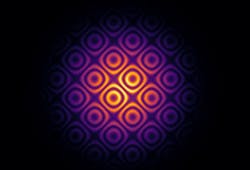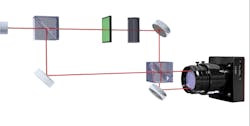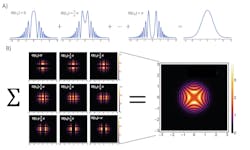Quantum-inspired phase imaging is immune to instabilities
A quantum-inspired phase imaging method based on light intensity correlation measurements created by a team of researchers led by Radek Lapkiewicz’s Quantum Imaging Lab at the University of Warsaw, along with colleagues from Stanford University and Oklahoma State University, is robust to phase noise—which means it operates even under unstable conditions and extremely dim illumination (see video).
Standard images are captured by measuring the intensity (brightness) of light pixel by pixel. Light is characterized its intensity and phase, and transparent objects can become visible if you measure the phase delay of light they introduce.
The team’s phase imaging method was inspired “by the works of Leonard Mandel on the interference of independent sources and Hong-Ou-Mandel effect—especially when generalized to spatially dependent phase profiles of photons,” says Jerzy Szuniewicz, a Ph.D. student at the University of Warsaw. “Observation of spatial phase dependence on the Hong-Ou-Mandel effect made us wonder if there’s a classical equivalent of this quantum effect, and it’s how we got our idea.”
In the 1960s, Mandel and his group showed that even if interference isn’t detectable in intensity, correlations can reveal its presence. So Lapkiewicz’s team decided to explore how intensity correlation measurements can be used for phase imaging.
For a correlation measurement, researchers examine pairs of pixels to see if they get brighter or darker at the same time.
And the team showed these measurements contain more information than can be obtained via a single photo, such as intensity measurement. The researchers went on to use this to demonstrate that in phase imaging based on interference, observations are possible even when standard interferograms average out losing all the phase information and no fringes are recorded in the intensity.
“With a standard approach, we’d assume there’s no useful information in such an image,” says Lapkiewicz. “But it turns out information is hidden within the correlations and can be recovered by analyzing multiple independent photos of an object—which allows us to obtain perfect interferograms, although the ordinary interference is undetectable due to the noise.”
Intensity-intensity correlation experiment
In the team’s experiment, light passes through a phase object—a target being explored—and is superimposed with a reference light. A random phase delay is introduced between the object and the reference light beams, which simulates a disturbance obstructing standard phase imaging methods.
No interference is observed when the intensity is measured, which means no information can be obtained about the phase object from the intensity measurement. But, intriguingly, the spatially dependent intensity-intensity correlation displays a fringe pattern that contains the complete information about the phase object.
It turns out this intensity-intensity correlation “is unaffected by any temporal phase noise varying slower than the speed of the detector—~10 nanoseconds for our experiment—and can be measured by accruing data over an arbitrarily long time period, which is a gamechanger,” explains Szuniewicz. “A longer measurement means more photons, which translates to greater accuracy.”
If they recorded a single film frame, it would provide no useful information about the object being studied. So the team recorded a series of frames using a camera, and then multiplied the measurement values at each pair of points from every frame. Averaging these correlations provides a full image of the object.
“We combined standard interferometry with intensity correlation measurements, then we simply averaged these correlations to get our phase imprinted onto the measured correlations,” says Szuniewicz. “Our setup is just an interferometer with a target phase and a phase-noise source—with a twist of clever data analysis. And the correlation method works for any interference phenomenon.”
The team proved that their method based on intensity-intensity correlation and an off-axis holography technique is optimal for reconstruction precision. Their method works well for any light statistics—such as single photons, thermal light from a lightbulb, or coherent light from a laser—and this is its greatest advantage.
A big surprise was in store for the researchers when they realized the effects observed by Mandel have implications for standard interferometry and phase imaging. “The beauty and simplicity of the math describing the phenomena is amazing—a first-year student can derive it,” says Szuniewicz. “And it’s optimal—there’s no way to get more information from the data than we obtained. We proved it by using the Cramer-Rao bound, which shows that the information extracted with our method is equal to all of the information present in the experimental data. It’s cool when you reach this ultimate precision.”
One of the biggest challenges the team faced with this work was journal editors and reviewers who essentially pushed them to perform experiments for two-dimensional (2D) phase masks.
“We avoided it because 2D phase reconstruction using this method, to be optimal, requires us to work in a four-dimensional (4D) space,” says Szuniewicz. “It was a challenge to analyze the data and understand how to interpret the results. But the 2D phase retrieval worked much better than we anticipated and helped us show the noise removal feature of our method.”
Applications for dark environments
A phase imaging approach based on intensity correlation can be used widely within very noisy environments, and the team’s method works with both classical—laser and thermal—and quantum light. This means their method has an extremely wide range of potential applications in phase measurements, including emerging applications such as infrared and x-ray imaging and quantum and matter-wave interferometry.
The applications are “countless,” Szuniewicz says with a laugh. “Our method can help with precise measurements of interference everywhere phase stability is a problem. It works for visible light, but also for more exotic interference like x-rays or even matter waves.”
It may also find applications in photon counting, for example, using single-photon avalanche diodes. It’s ideal for cases in which little light is available or when high light intensity must be avoided to prevent damage to objects like a delicate biological sample or a work of art.
“I’d be thrilled to see our technique applied to matter-wave interferometry or exotic spectral ranges such as x-rays—we’re always happy to discuss it, so if you have ideas let us know,” says Lapkiewicz.
Remote sensing seems to be “a natural scenario where interference fringes are extremely challenging to observe,” Lapkiewicz says, “and our technique can help to see them in intensity correlations.”
FURTHER READING
J. Szuniewicz et al., Sci. Adv., 9, 38 (Sep. 22, 2023); doi:10.1126/sciadv.adh5396.

Sally Cole Johnson | Editor in Chief
Sally Cole Johnson, Laser Focus World’s editor in chief, is a science and technology journalist who specializes in physics and semiconductors. She wrote for the American Institute of Physics for more than 15 years, complexity for the Santa Fe Institute, and theoretical physics and neuroscience for the Kavli Foundation.



